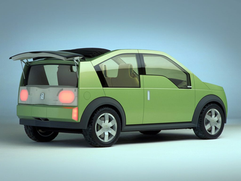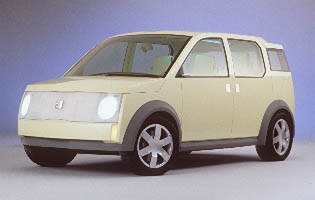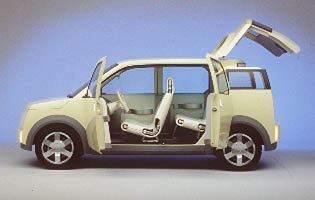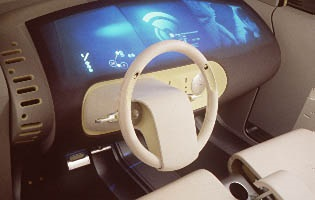The Bonkers History of the 2000s Ford 24.7 Concepts
- Story Cars

- Jan 16, 2024
- 3 min read

In 2000, Ford unveiled a groundbreaking series of concept cars at the North American International Auto Show (NAIAS) in Detroit. The 24.7 series, comprising the Coupe, Pickup, and Wagon models, aimed to redefine automotive design and connectivity for the new millennium. Although met with mixed reactions, these concepts showcased Ford's bold attempt to bridge the gap between traditional automobile design and the emerging era of digital integration.
1. The 24.7 Coupe
The 24.7 Coupe, a standout in Ford's 24.7 series, attracted attention for its unique approach to automotive design. Presented at NAIAS 2000, the coupe faced a spectrum of reactions, with some critics dubbing it a flop due to its defiantly primitive design. However, proponents saw it as Ford's endeavor to revolutionize mass automotive design for the 21st century.
Design Philosophy
It was led by Ford's Design Vice President J. Mays, the 24.7 Coupe embraced simplicity and advanced technologies. The name "24.7" reflected a commitment to constant availability, aligning with the contemporary perception of cars as essential as computers. The exterior featured transparent plastic, transitioning from solid to transparent or colored, mirroring the design simplicity of Dell or Macintosh computers.
Innovative Features
The coupe boasted distinctive features, including 'lipstick cameras' replacing traditional door mirrors, a convertible-like dark green roof, and a lighting system with white and red LED lamps. The minimalist interior showcased bench-like seats resembling a clamshell, covered in light beige leather with aluminum accents.
Technologically, the 24.7 Coupe integrated Visteon's Voice Technology, allowing hands-free controls and multilingual voice commands. The Reconfigurable Projected Image Display enabled drivers to customize the dashboard layout through voice commands. The coupe's one-spoke steering wheel housed auto/manual shift controls and a hands-free videophone with a mounted camera.
Built on the Ford Focus platform with a 2.0-liter Zetec I-4 engine, the 24.7 Coupe aimed to provide 24/7 access to information, communication, and personalized features, reflecting the evolving role of cars in people's lives.
2. The 24.7 Pickup
The 24.7 Pickup, another member of Ford's innovative series, debuted alongside the coupe. Despite initial skepticism about its unconventional design, this model aimed to offer a versatile solution for individuals with diverse lifestyles.
Design Innovation
Like its coupe counterpart, the 24.7 Pickup showcased Ford's commitment to pushing design boundaries. The series sought to challenge conventional perceptions of cars and their role in modern life. With its minimalist and angular design, the pickup aimed to provide an ideal vehicle for various adventures, from off-road exploration to city commuting.
Technological Advancements
Technologically, the pickup integrated Visteon's cutting-edge features, including Voice Technology and the Reconfigurable Projected Image Display. The pickup's lighting system featured white and red LED lamps, contributing to energy efficiency and unique styling.
3. The 24.7 Wagon
The 24.7 Wagon, the third member of Ford's concept trilogy, targeted the family-oriented market. Blurring the lines between traditional estate cars and SUVs, this model sought to provide a vehicle that catered to the dynamic needs of modern families.
Adaptable Design
Designed with flexibility, the 24.7 Wagon featured rear seats that could fold down flush to the floor, increasing its carrying capacity. The exterior design embraced geometric shapes and machined surfaces, imparting a technical look in line with the advanced communications and telematics technologies of the 24.7 series.
Shared Technological Prowess
The Wagon shared technological prowess with its counterparts, incorporating Visteon's Voice Technology and the Reconfigurable Projected Image Display. The advanced lighting system with white and red LED lamps provided both style and efficiency.
Conclusion: Ford's Visionary Leap
Ford's 24.7 Concept Series marked a visionary leap into the future of automotive design and connectivity. While initially met with skepticism and divided opinions, these concepts paved the way for discussions about the evolving role of cars in people's lives. The series, with its commitment to simplicity, innovation, and 24/7 connectivity, hinted at a future where automobiles seamlessly integrate with our daily routines, becoming more than just modes of transportation. Ford's bold attempt to redefine automotive design in the 21st century showcased the company's commitment to pushing boundaries and embracing the technological era. As the automotive industry continues to evolve, the legacy of the 24.7 series is a testament to the ongoing quest for innovation and progress.



















































Comments